As a gardener or farmer, understanding the onion plant growth stages is crucial to ensure a successful harvest. Onions are a popular crop due to their versatility in cooking and long shelf life. Knowing the Onion Plant Growth Stages can help you plan for planting, monitor growth, and determine when to harvest.
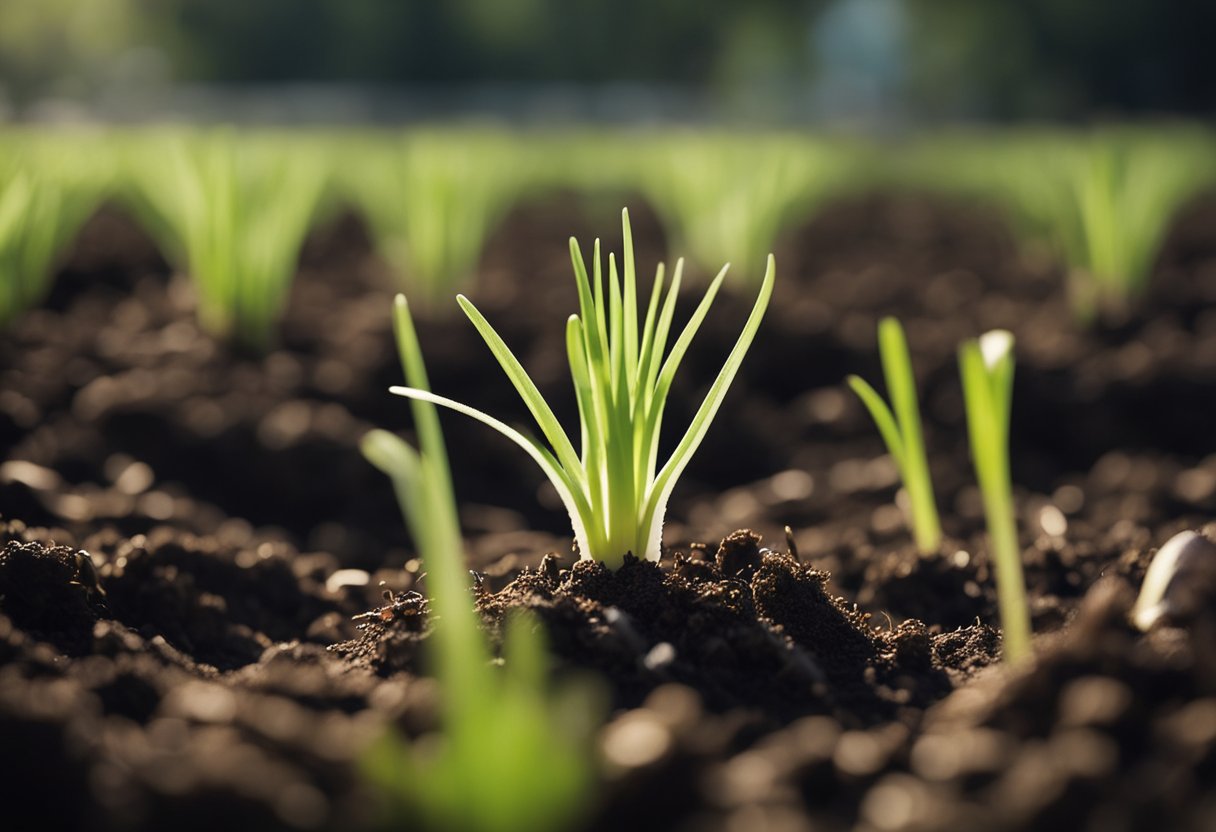
Onion Biology and Botany Onions belong to the Allium family and are biennial plants, meaning they complete their life cycle in two growing seasons. Onions grow from seeds, and their growth stages include seed germination, vegetative growth, bulbing, and maturation. Each stage is characterized by specific changes in the plant’s appearance and behavior.
Key Takeaways
- Understanding the onion plant growth stages is essential for a successful harvest.
- Onions are biennial plants that complete their life cycle in two growing seasons.
- The onion growth cycle includes seed germination, vegetative growth, bulbing, and maturation.
Onion Biology and Botany
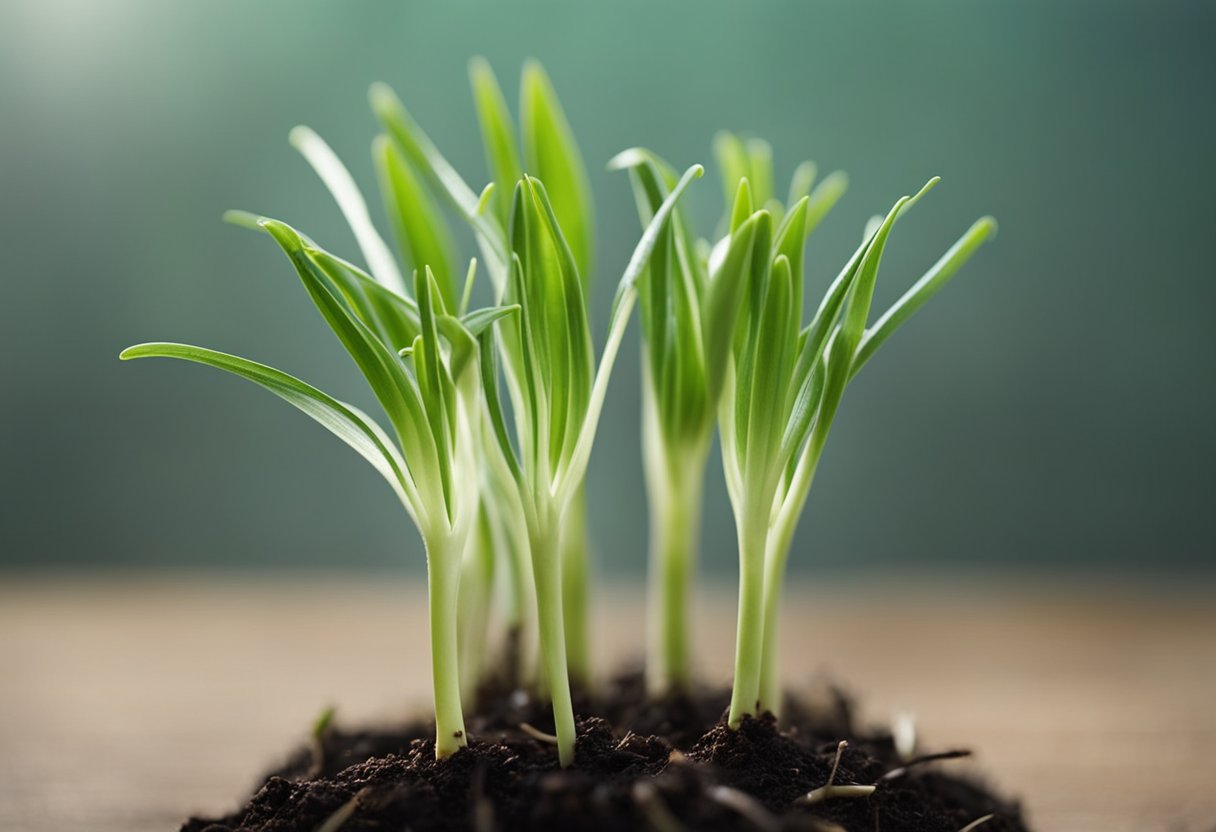
Onions are biennial plants that belong to the Allium family, which also includes garlic, leeks, and chives. The scientific name for onion is Allium cepa. The onion bulb is composed of layers of fleshy leaves that store nutrients for the plant. The leaves are attached to a basal plate that forms the bottom of the bulb. The onion plant produces a long, hollow stem that emerges from the center of the bulb and grows upward to form a flower stalk.
Onions are classified as cool-season crops and are typically grown in the spring or fall. They grow best in soil that is well-drained, fertile, and high in organic matter. Onions require full sun and regular watering to grow properly. They have a shallow root system and are sensitive to drought, so it is important to keep the soil moist.
Onion plants go through six stages of growth, starting with seed germination and ending with maturation. The first stage is seed germination, which occurs when the seed absorbs water and begins to sprout. The second stage is the seedling stage, during which the plant develops its first true leaves. The third stage is vegetative growth, during which the plant grows leaves and a root system. The fourth stage is bulb initiation, during which the plant begins to form a bulb in the soil. The fifth stage is bulb maturation, during which the bulb grows and develops its characteristic flavor and aroma.
The final stage is maturation, during which the plant moves resources from the leaves to the bulb, causing the leaves to turn yellow and eventually fall over, signaling that it is time to harvest the onions.
Understanding the biology and botany of onions is essential for successfully growing and harvesting these delicious and versatile vegetables. With proper care and attention, onion plants can produce a bountiful harvest that will add flavor and nutrition to any meal.
Seed Germination Stage
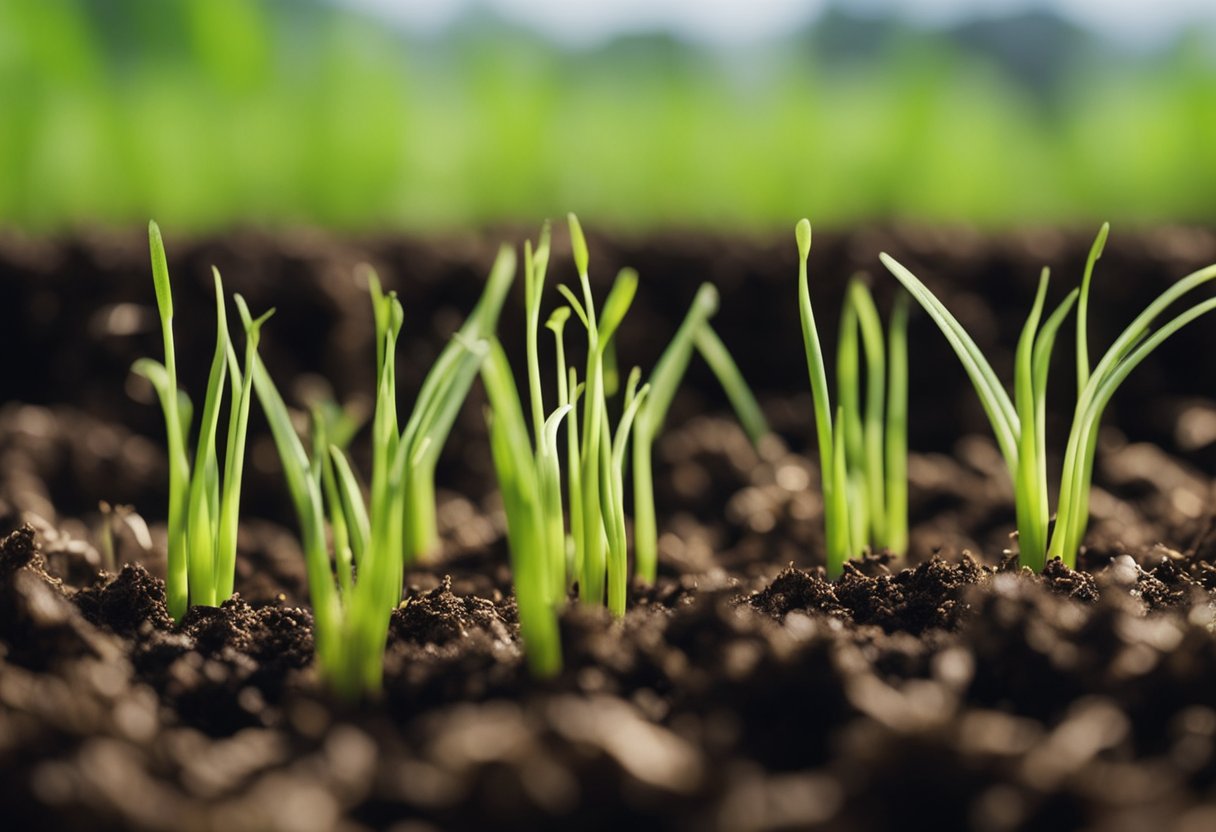
As I begin to explore the different stages of onion plant growth, the first stage that comes to mind is the seed germination stage. This is the stage when the onion seed is planted in the soil and starts to absorb water. The seed then begins to swell and eventually cracks open.
Seed Selection and Treatment
Before planting the onion seeds, it’s important to select high-quality seeds. The seeds should be firm, plump, and free from any damage or deformities. It’s also recommended to treat the seeds with a fungicide before planting to prevent any soil-borne diseases from affecting the seedlings.
Germination Process
Once the seeds have been selected and treated, it’s time to plant them in the soil. The ideal soil temperature for onion seed germination is between 60-75°F (15-24°C). The seeds should be planted about 1/4 inch (0.6 cm) deep and spaced about 1-2 inches (2.5-5 cm) apart.
After planting, it’s important to keep the soil moist but not waterlogged. The seeds should begin to germinate within 7-10 days. During this stage, the seedlings will develop a root system and a small shoot will emerge from the soil.
The seed germination stage is the first step in the onion plant growth cycle. By selecting high-quality seeds and providing the proper growing conditions, you can ensure a successful germination process and set your onion plants up for healthy growth in the following stages.
Vegetative Growth Phase
During the vegetative growth phase of the onion plant, it focuses on developing its root system and leaves. This phase is crucial for the plant’s development as it prepares the plant for the next stages of growth.
Root Development
The onion plant’s root system is established during the vegetative growth phase. The roots grow in a downward direction, searching for water and nutrients in the soil. As the roots grow, they become more extensive, allowing the plant to absorb more water and nutrients from the soil.
The onion plant’s root system is essential for the plant’s survival as it provides the necessary nutrients and water for the plant to grow healthy and strong. A healthy root system ensures that the plant can withstand environmental stressors such as drought and extreme temperatures.
Leaf Formation
During the vegetative growth phase, the onion plant also focuses on developing its leaves. The leaves are essential for the plant’s growth as they help in photosynthesis, the process by which the plant produces its food.
The onion plant’s leaves are long and slender, with a bluish-green color. As the plant grows, more leaves are produced, which become wider and longer. The leaves of the onion plant are also responsible for storing energy, which is used during the next stages of growth.
The vegetative growth phase is a critical stage in the onion plant’s life cycle. During this phase, the plant focuses on developing its root system and leaves, which are essential for its growth and survival. A healthy root system and leaf formation ensure that the plant can withstand environmental stressors and produce healthy and robust bulbs.
Bulbing Stage
The bulbing stage is when the onion plant redirects its energy from vegetative growth to the formation of bulbs. This stage is crucial for the development of the onion bulb, which is the part of the plant that is harvested and used in cooking.
Bulb Initiation
Bulb initiation occurs when the daily sunlight reaches a certain length. At this point, the onion plant will redirect its energy from vegetative growth to the formation of bulbs. During this stage, you should notice some lifting or cracking of the soil when the bulbs start to form.
Bulb Development
After bulb initiation, the onion plant will continue to develop bulbs. During this stage, the onion bulb will increase in size and weight. It is important to ensure that the onion plant receives adequate water and nutrients during this stage to promote healthy bulb development.
To promote healthy bulb development, it is recommended to thin out the damaged and weak onions, keeping 4 to 6 inches apart. This will allow the remaining onions to receive adequate nutrients and water, which will promote healthy bulb development.
The bulbing stage is crucial for the development of the onion bulb. During this stage, the onion plant redirects its energy from vegetative growth to the formation of bulbs. Adequate water and nutrients are necessary for healthy bulb development.
Maturation and Harvest
Bulb Maturation
As the onion plant grows, it reaches the maturation stage, which is the final stage of its life cycle. During this stage, the plant moves resources from the leaves to the bulb, causing the leaves to turn yellow and eventually fall over. When most of the leaves have fallen, the onion bulb is signaling that it is ready for harvest. The maturation process takes approximately 100 to 175 days depending on the onion variety and growing conditions.
It is important to monitor the onion bulbs during the maturation stage to ensure that they do not rot or become diseased. Excessive moisture or high temperatures can cause the onion bulbs to rot, while fungal diseases can cause them to become discolored and soft.
Harvesting Techniques
Harvesting onions is a delicate process that requires careful handling to prevent damage to the bulbs. There are several techniques that can be used to harvest onions, including hand harvesting and mechanical harvesting.
Hand harvesting involves pulling the onions out of the ground by hand and laying them on the ground to dry. This technique is best suited for small-scale onion farming operations.
Mechanical harvesting involves using specialized equipment to lift the onions out of the ground and transport them to a drying area. This technique is best suited for large-scale onion farming operations.
Once the onions have been harvested, they should be left to dry in a well-ventilated area for several weeks. After the onions have dried, they can be stored in a cool, dry place for several months. Properly harvested and stored onions can be enjoyed throughout the year in a variety of dishes.
Also Read | Fruit Trees That Grow In Zone 6 and Crop: A Guide
Post-Harvest Handling
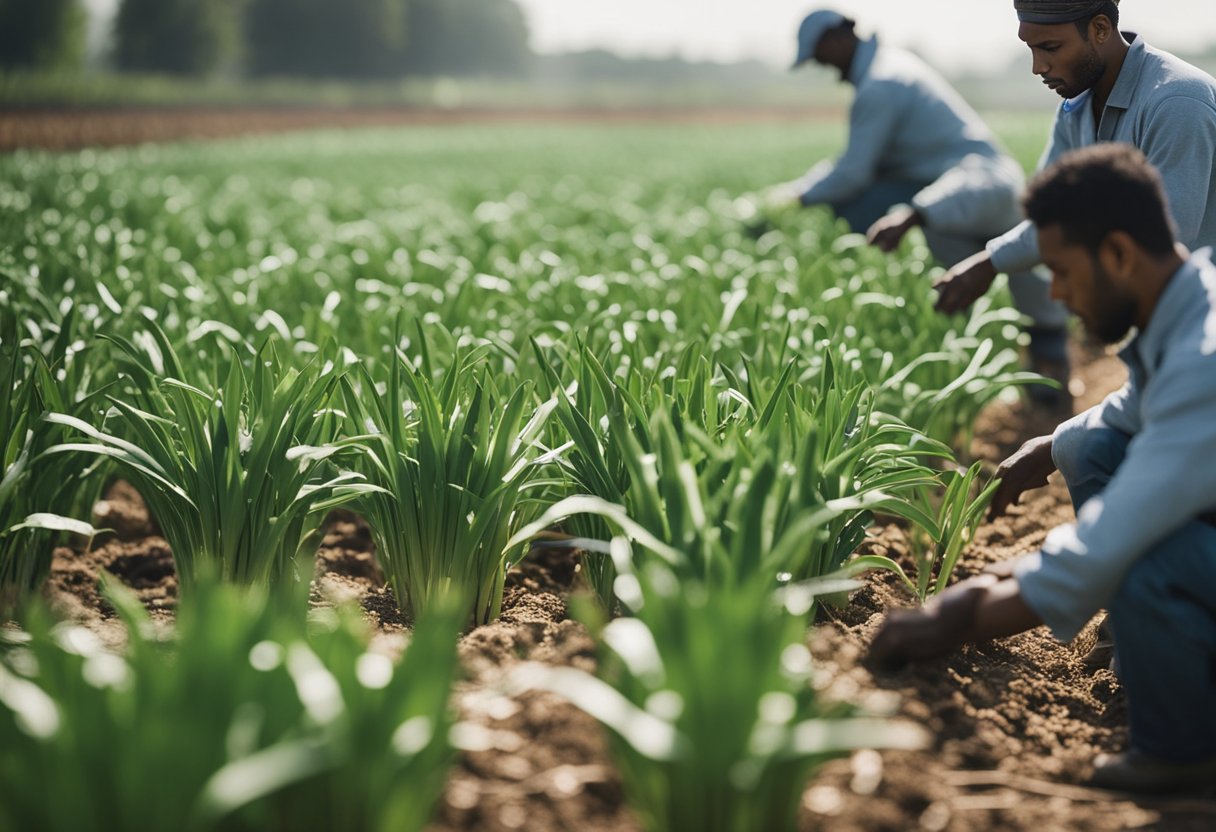
After harvesting, onions must be properly handled to ensure they remain in good condition. In this section, I will discuss the two main aspects of post-harvest handling: the curing process and storage conditions.
Curing Process
The curing process is an essential step in post-harvest handling of onions. It involves drying the onions to help them last longer in storage. After harvesting, the onions should be left in the field for a few days to dry out. This helps to toughen the outer layers of the onion, making them less susceptible to damage during storage.
Once the onions have been left to dry in the field, they should be moved to a well-ventilated area to complete the curing process. The onions should be spread out in a single layer, and the temperature should be maintained between 20-30°C with relative humidity of 65-70%. This process can take up to 2-4 weeks.
Storage Conditions
The storage conditions for onions are crucial to maintaining their quality and longevity. After the curing process, the onions should be stored in a cool, dry place with good ventilation. The ideal temperature for storing onions is between 0-5°C, with a relative humidity of 65-70%.
Onions should be stored in a single layer, and not piled on top of each other. Storing onions in a pile can cause them to bruise and rot. It is also important to ensure that the storage area is free from pests and rodents, as they can damage the onions.
Proper post-harvest handling is crucial to maintain the quality and longevity of onions. The curing process and storage conditions are two important aspects that must be taken into consideration. By following these guidelines, onions can be stored for several months without losing their quality.
Plant Nutrition and Soil Management
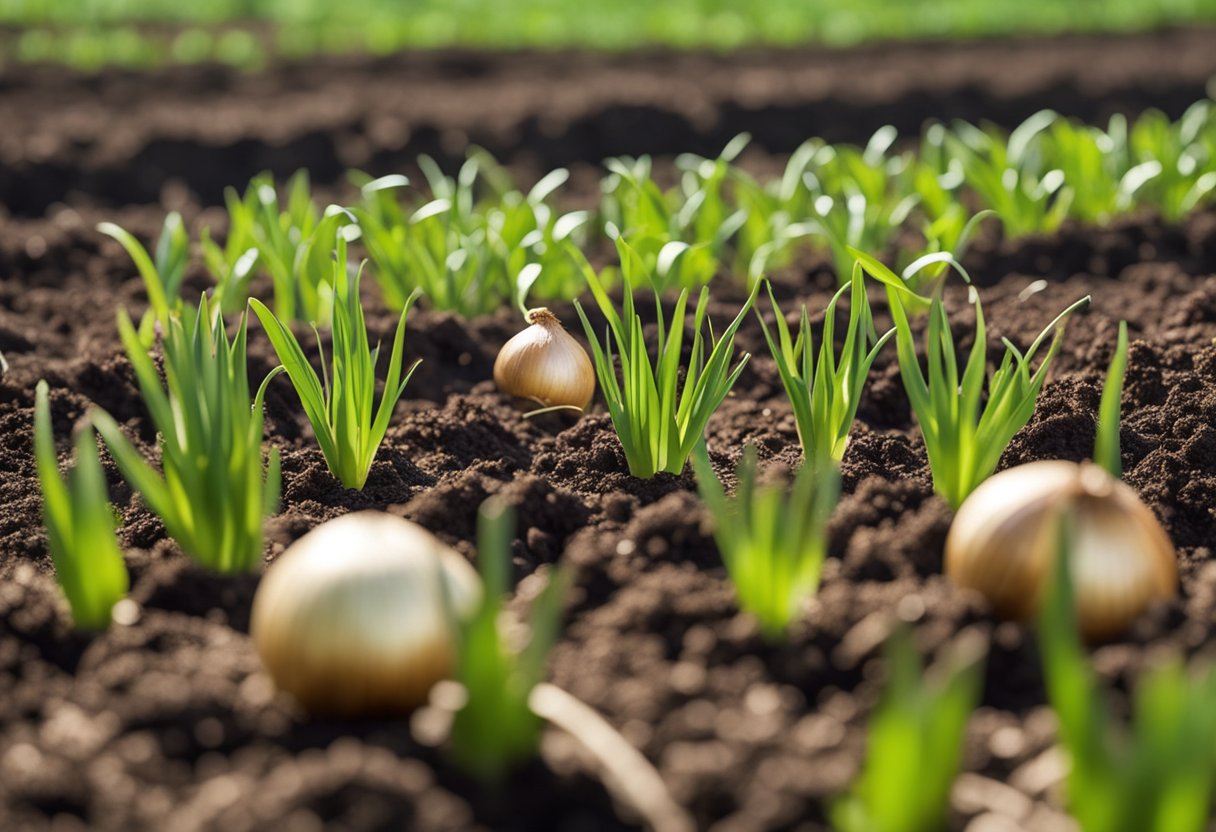
Soil Preparation
In order to ensure proper onion plant growth, it is important to start with well-prepared soil. The soil should be loose, well-draining, and have a pH between 6.0 and 7.0. It is recommended to add organic matter such as compost or well-rotted manure to the soil to improve its texture and fertility.
Before planting, the soil should be tilled to a depth of at least 8 inches to loosen it up and ensure that the onion roots can penetrate it easily. It is important to remove any weeds or debris from the soil to prevent competition for nutrients and water.
Fertilization Strategy
Onions require a steady supply of nutrients throughout their growth cycle. A balanced fertilizer with equal amounts of nitrogen, phosphorus, and potassium can be used to provide the necessary nutrients.
It is recommended to fertilize the soil before planting the onion bulbs. A general rule of thumb is to apply 2-3 pounds of fertilizer per 100 square feet of soil. The fertilizer should be worked into the soil to a depth of 4-6 inches.
During the growing season, it is important to monitor the onion plants for signs of nutrient deficiencies. If the leaves start to yellow or the plants appear stunted, additional fertilizer may be needed. It is important to follow the manufacturer’s instructions when applying fertilizer to avoid over-fertilization, which can lead to burning of the plants.
In addition to fertilizer, it is important to provide the onion plants with adequate water. Onions require about 1 inch of water per week, either from rainfall or irrigation. It is recommended to water deeply and infrequently to encourage deep root growth and prevent waterlogging of the soil.
Pest and Disease Management
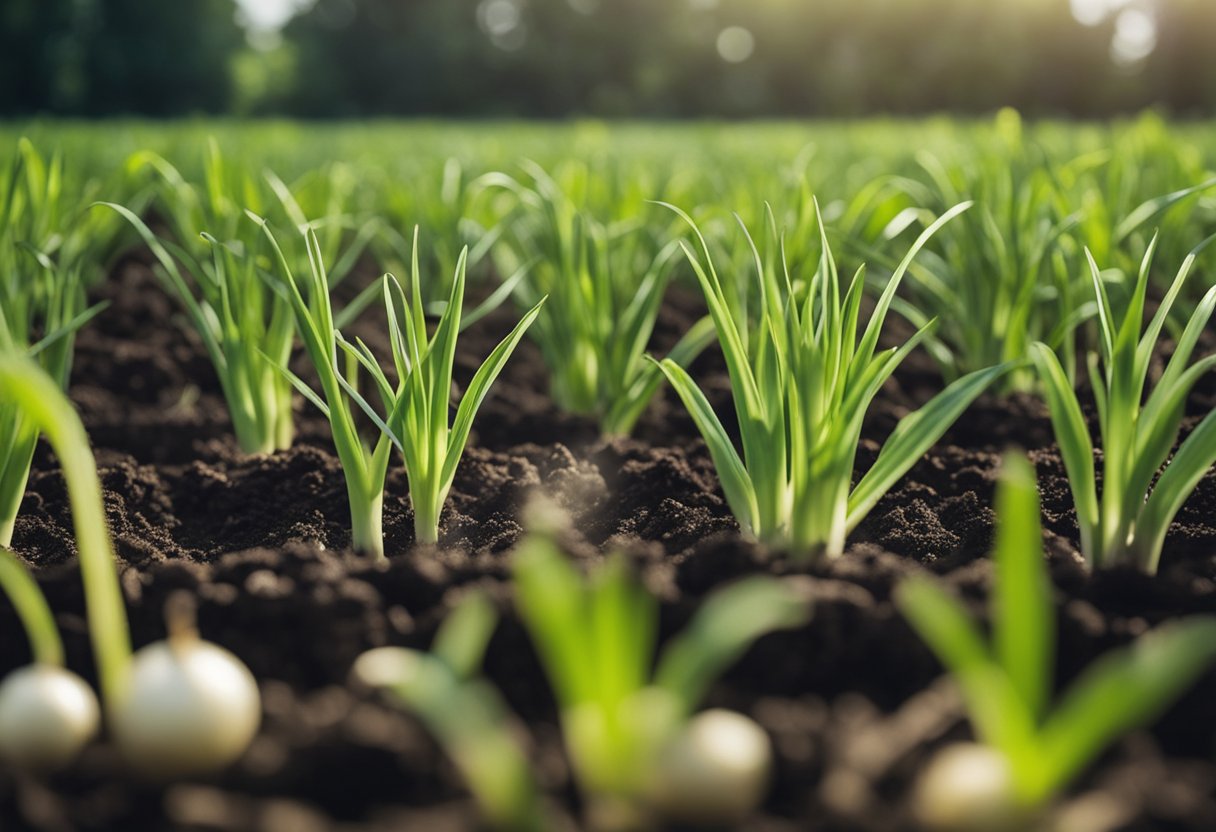
Common Pests
As with most plants, onions can be susceptible to pests. Some of the most common pests that can affect onion plants include onion maggots, thrips, and cutworms. Onion maggots are small, white larvae that feed on the roots of onion plants, while thrips are tiny insects that can damage the leaves and stems of onion plants. Cutworms, on the other hand, are caterpillars that can cut through the stems of onion plants, causing them to wilt and die.
To prevent these pests from damaging your onion plants, it is important to practice good garden hygiene. This includes removing any plant debris from the garden and rotating your crops each year. You can also use insecticidal soaps or neem oil to control thrips and cutworms, and yellow sticky traps to catch onion maggots.
Disease Prevention
In addition to pests, onion plants can also be susceptible to various diseases. Some of the most common diseases that can affect onion plants include onion smut, white rot, and downy mildew. Onion smut is a fungal disease that can cause black, powdery growths on the leaves and stems of onion plants, while white rot is a fungal disease that can cause the roots of onion plants to rot.
To prevent these diseases from affecting your onion plants, it is important to practice good garden hygiene. This includes removing any plant debris from the garden and rotating your crops each year. You can also use fungicides to control fungal diseases, and avoid planting onions in areas where these diseases have been a problem in the past.
By taking a few simple steps to prevent pests and diseases, you can help ensure that your onion plants grow healthy and strong, and produce a bountiful harvest.
Environmental Factors Affecting Growth
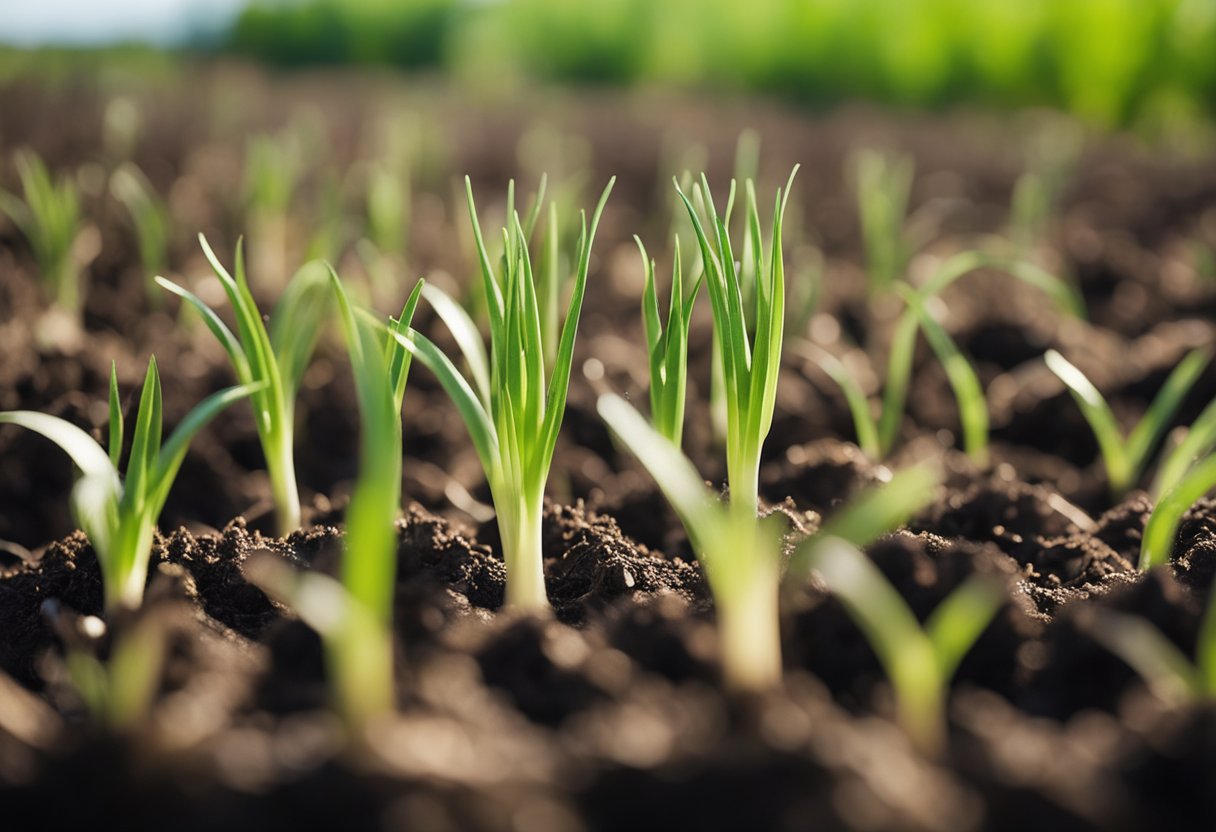
Temperature Requirements
Onion plants are cool-season crops that require specific temperature ranges to grow optimally. The ideal temperature for onion growth is between 60°F and 75°F (15.5°C to 24°C). At temperatures below 50°F (10°C), onion growth slows down, and the plant may become dormant. Temperatures above 85°F (29.4°C) can cause onion plants to bolt, which means they will begin to produce flowers prematurely.
Watering Regimen
Onion plants require a consistent supply of water, especially during the early stages of growth. Onions require approximately 1 inch (2.5 cm) of water per week, either from rainfall or irrigation. However, the amount of water required can vary depending on the temperature, humidity, and soil type. Overwatering can lead to rotting of the roots and bulbs, while under-watering can cause the plants to wilt and stunt their growth.
It is important to note that the timing and amount of water given to onion plants can also affect their growth. During the vegetative growth stage, onion plants require more water than during the bulb formation stage. It is recommended to reduce watering once the onion bulbs begin to mature, as this can help prevent rotting and improve the quality of the harvested onions.
Maintaining optimal temperature ranges and providing consistent watering can help promote healthy onion plant growth and improve the yield of the harvested onions.
Onion Growth Cycle Monitoring
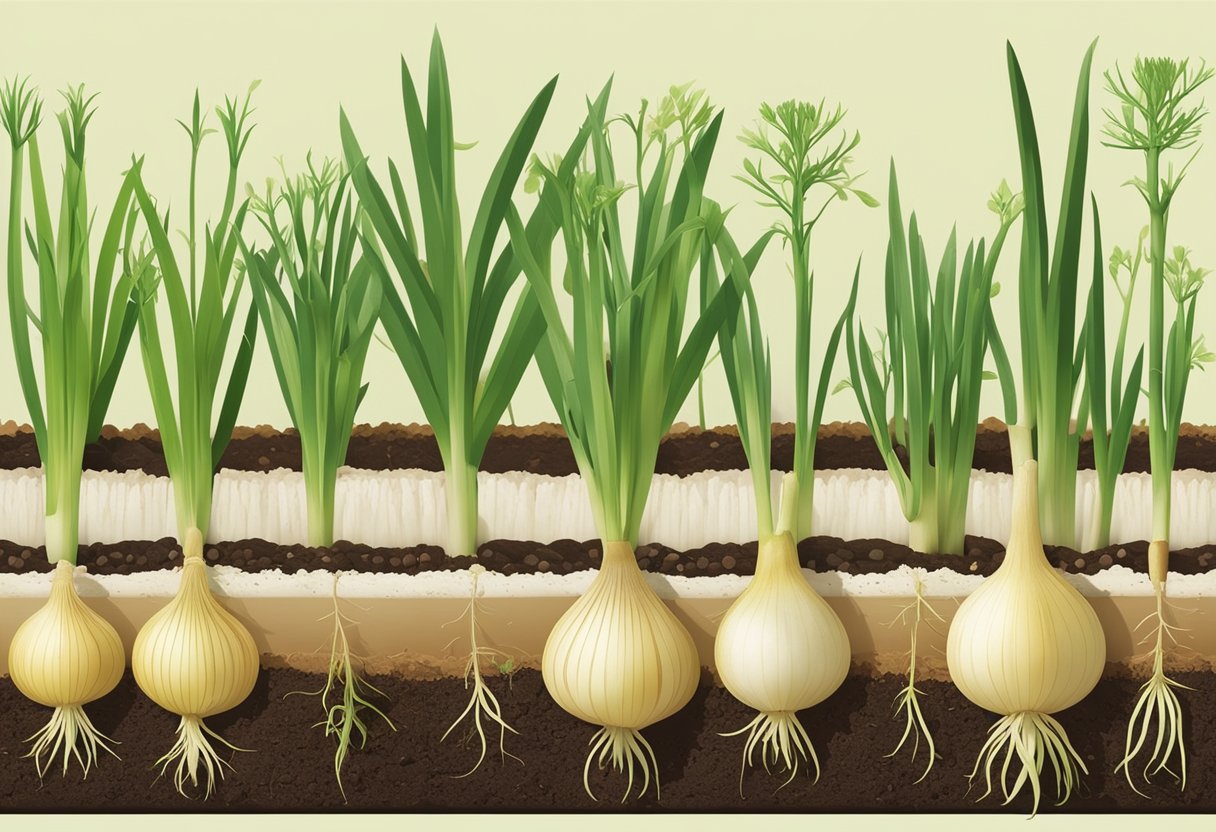
Growth Stages Assessment
As an onion grows, it goes through different stages of development. It is important to monitor these stages to ensure proper growth and development of the plant. The stages of onion growth are germination, seedling, vegetative growth, bulb formation, maturation, and harvest.
During the germination stage, the onion seed will sprout and begin to grow into a seedling. At this stage, it is important to keep the soil moist and provide adequate light for the seedling to grow.
In the seedling stage, the onion will grow leaves and develop a root system. At this stage, it is important to provide the onion with sufficient water and nutrients to support its growth.
The vegetative growth stage is when the onion plant grows leaves and a root system. At this stage, it is important to thin out the damaged and weak onions, keeping them 4 to 6 inches apart.
During the bulb formation stage, the onion will begin to form a bulb. At this stage, it is important to ensure the onion is receiving enough water and nutrients to support the development of the bulb.
In the maturation stage, the onion plant moves resources from the leaves to the bulb, causing the leaves to turn yellow and eventually fall over. This signals that the onion is ready for harvest.
Yield Estimation
Yield estimation is an important part of onion growth cycle monitoring. By estimating the yield, you can determine the amount of onions you can expect to harvest and plan accordingly.
One way to estimate the yield is to count the number of leaves on the onion plant. The more leaves the onion plant has, the larger the bulb will be, and the higher the yield will be.
Another way to estimate the yield is to measure the diameter of the onion bulb. The larger the diameter of the bulb, the higher the yield will be.
By monitoring the growth stages of the onion plant and estimating the yield, you can ensure a successful onion harvest.
FAQs – Onion Plant Growth Stages
What are the distinct phases of growth in onions from seed to harvest?
Onions go through several stages of growth from seed to harvest. These stages include germination, seedling, vegetative growth, bulb formation, maturation, and harvesting. Each stage is critical to the plant’s development and overall health.

How much time is typically required for onions to fully mature?
Onions typically take around 100-120 days to fully mature. This time frame can vary depending on the variety of onion, the growing conditions, and the climate. It’s important to monitor the plants closely during the maturation stage to ensure that they are harvested at the right time.
Can you describe the life cycle stages of an onion plant?
The life cycle stages of an onion plant include germination, seedling, vegetative growth, bulb formation, maturation, and harvesting. During the germination stage, the onion seed sprouts and sends out a shoot. The seedling stage is when the plant begins to grow rapidly, producing green leaves and a white bulb. The vegetative growth stage is when the onion plant grows leaves and a root system. The bulb formation stage is when the onion begins to form its bulb. During the maturation stage, the plant moves resources from the leaves to the bulb, causing the leaves to turn yellow and eventually fall over. The harvesting stage is when the onions are ready to be picked.
At what stage does onion bolting occur and what triggers it?
Onion bolting occurs during the vegetative growth stage when the plant grows tall and sends up a flower stalk. Bolting is triggered by environmental factors such as temperature, day length, and moisture levels. Once an onion plant bolts, the bulb stops growing and becomes bitter.
What are the key differences between growing onions from seeds versus bulbs?
Growing onions from seeds requires more time and effort than growing from bulbs. Seeds need to be started indoors or in a greenhouse and then transplanted to the garden. Bulbs, on the other hand, can be planted directly in the garden. Seeds also offer more variety in terms of onion types and flavors, while bulbs are limited to the varieties available in stores.
How can you identify each growth stage in a spring onion’s development?
In a spring onion’s development, the germination stage is when the seed sprouts and sends out a shoot. The seedling stage is when the plant begins to grow rapidly, producing green leaves and a white bulb. The vegetative growth stage is when the onion plant grows leaves and a root system. The bulb formation stage is when the onion begins to form its bulb. During the maturation stage, the plant moves resources from the leaves to the bulb, causing the leaves to turn yellow and eventually fall over. The harvesting stage is when the onions are ready to be picked.